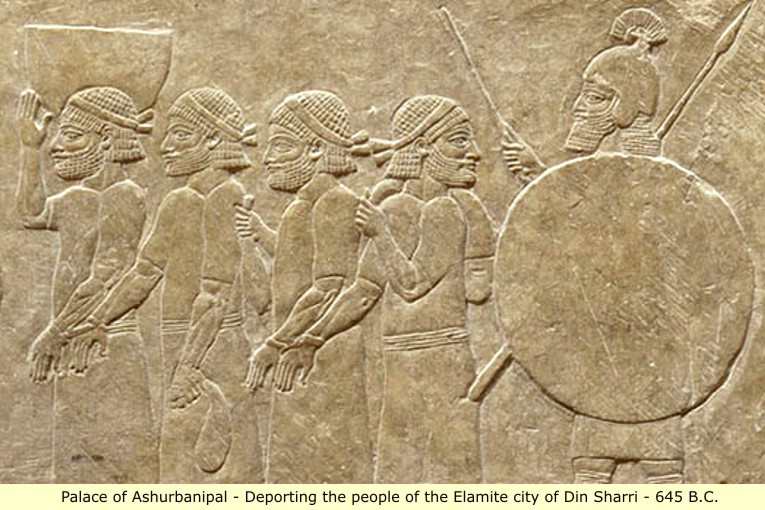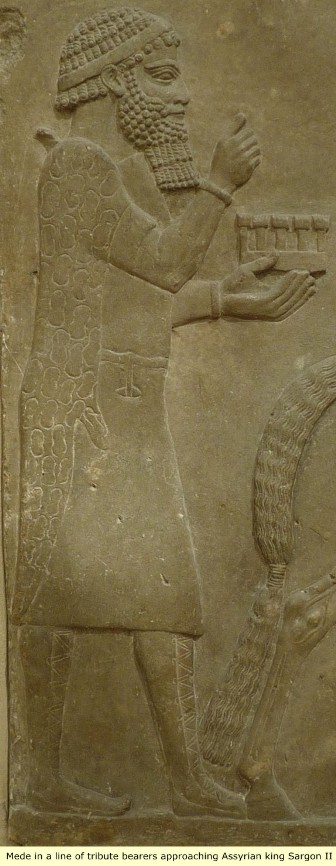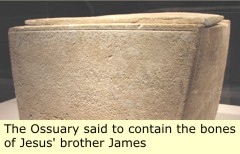The Assyrians
The Middle Elamite period
After two centuries for which sources reveal nothing, the Middle Elamite period opened with the rise to power of the Anzanite dynasty, their homeland probably lay in the mountains northeast of Khuzestan. Political expansion under the fourth king of this line "Khumbannumena" (1285 B.C.) proceeded along, and his successes were commemorated by his assumption of the title “Expander of the Empire.”


He was succeeded by his son Untash-Gal, a contemporary of Shalmaneser I of Assyria (1274- B.C.). Untash founded the city of Dur Untash (modern Chogha Zanbil). In the years immediately following Untash-Gal, Elam increasingly found itself in real or potential conflict with the rising power of Assyria. Tukulti-Ninurta I of Assyria (1244 B.C.) campaigned in the mountains north of Elam. The Elamites under Kidin-Khutran, second king after Untash-Gal, countered with a successful and devastating raid on Babylonia. In the end however, Assyrian power seems to have been too great. Assyrian king Tukulti-Ninurta managed to expand Assyrian control well into Elamite territory, King Kidin-Khutran faded into obscurity, and the Anzanite dynasty came to an end.
After a short period of dynastic troubles, the second half of the Middle Elamite period opened with the reign of King Shutruk-Nahhunte (1160 B.C.). Two equally powerful and two less impressive kings followed this founder of a new dynasty; their capital was probably Susa. In this period Elam became one of the great military powers of the Middle East. The door was opened for them when Assyrian king Tukulti-Ninurta died about 1208 B.C, and Assyria fell into a period of internal weakness and dynastic conflict.
Elam was quick to take advantage of this situation by campaigning extensively in the Diyala River area and into the very heart of Mesopotamia. Shutruk-Nahhunte captured Babylon and carried off to Susa the stele on which was inscribed the famous law code of Hammurabi. Shilkhak-In-Shushinak, brother and successor of Shutruk-Nahhunte's eldest son, Kutir-Nahhunte, still anxious to take advantage of Assyrian weakness, campaigned as far north as the area of modern Kirkuk.
 |
In Babylonia however, the 2nd dynasty of Isin led a native revolt against the Elamites, and Elamite power in central Mesopotamia was eventually broken. The Elamite military empire began to shrink rapidly. Nebuchadrezzar I of Babylon (1,124 B.C.) attacked Elam and was just barely beaten off. A second Babylonian attack succeeded, however, and the whole of Elam was apparently overrun, ending the Middle Elamite period.
 |
The Neo-Elamite period

A long period of darkness separates the Middle and Neo-Elamite periods. In 742 B.C. a certain Huban-nugash is mentioned as king in Elam. The land appears to have been divided into separate principalities, with the central power fairly weak. The next 100 years witnessed the constant attempts of the Elamites, usually in alliance with Babylon, to thwart the constant pressure of Assyrian expansion. At times they were successful with this policy, both militarily and diplomatically, but on the whole, they were forced to give way to increasing Assyrian power. Local Elamite dynastic troubles were from time to time compounded by both Assyrian and Babylonian interference.
All the while, the Assyrian army whittled away at Elamite power and influence in Luristan. In time these internal and external pressures resulted in the near total collapse of any meaningful central authority in Elam. In a series of campaigns between 692 and 639 B.C, in an effort to clean up a political and diplomatic mess that had become a chronic headache for the Assyrians, Ashurbanipal's armies utterly destroyed Susa, pulling down buildings, looting, and sowing the land of Elam with salt.
 |
 |
 |
 |
The Medes
By the mid-9th century B.C, two new groups of people appear in Elam, these are the Medes (Mada) and the Persians (Parsua). Of the two, the Medes were the more widespread, and from an Assyrian point of view, the more important group. The Medes were fierce warriors and skilled horse breeders. They were at first organized as independent tribes, however this changed under the tribal chief Deioces, he succeeded in uniting all of the Medes tribes into the kingdom of Media. The Persians (Parsua) continued their migration southward into an area of southwestern Elam that we now call Fars, and made that their home.
 |
 |  |
Who were the Medes and Persians?
As is always the case with the ancient Black civilizations, Whites have spent their time producing falsehood and nonsense, in an attempt to make them appear to be White people, thus they have spent no time in trying to ascertain their true origin. So to this late date, there is still no clear understanding of where the Medes and Persians came from. So then, let us investigate.
The Persians and Medes are first mentioned in the records of Assyrian king Shalmaneser III (859 – 824 B.C.). In these records, Parsuwash (along with Matai of Median) are first mentioned as inhabiting the area of Lake Urmia, which is a salt lake in northwestern Iran, near Iran's border with Turkey, (Lake Matianus is an old name for Lake Urmia. It was the center of the Mannaean Kingdom). The exact identity of the Parsuwash is yet to be determined, but from a linguistic viewpoint the word matches Old Persian pārsa.
Note: though the Persians and Medes would later form a unified people, they did not begin as such, they were originally separate kingdoms.Approximately 250 years previous, the "Sea People" a conglomeration of Mediterranean warriors and their families seeking new homes, invaded Egypt.
The "Sea People" included: The Peleset and Tjeker (Minoans) of Crete, they would later be known as the “Philistines” after they had settled in Southern Canaan. Over time, this area became known by a form of their name “Palestine”. The Lukka who may have come from the Lycian region of Anatolia, The Ekwesh and Denen who seem to be identified with the original (Black) Greeks, The Shardana (Sherden) who may be associated with Sardinia, The Teresh (Tursha or Tyrshenoi), the Tyrrhenians - the Greek name for the Etruscans, and The Shekelesh (Sicilians?).
After being turned away in defeat by Egyptian king Rameses III, the Sea Peoples invaded Anatolia. There they are reported to have destroyed the central Anatolian Hittite Empire and settled there.
There is just a few problems with that scenario:
There never really was such a thing as a Hittite Empire. The name "Hittite" comes from an entry in the King James Bible (1611 A.D.), and for some unknown reason, White people decided to give this name to what was undoubtedly a Hattic kingdom in Anatolia. Then there is the fact that we cannot identify what was the new kingdom that the Sea Peoples formed. There is no doubt that the Sea Peoples DID displace some native Anatolian people. Who exactly they were, and where they went to is another unknown. There is the logical possibility that "Some" Sea People remained in Anatolia and settled there, and perhaps "Some" continued eastward. There is circumstantial evidence to support this scenario, and it all points to the Persians as being part of the Sea Peoples who continued on into Elam.
Quotes from the Histories of Herodotus, circa 440 B.C. will be used to support this scenario.
The Colchians:
According to the Greeks, Colchis was a fabulously wealthy land situated on the mysterious periphery of the heroic world. Here in the sacred grove of the war god Ares, King Aeëtes hung the Golden Fleece until it was seized by Jason and the Argonauts. Colchis was also the land where the mythological Prometheus was punished by being chained to a mountain while an eagle ate at his liver for revealing to humanity the secret of fire. Amazons also were said to be from Colchis. The main mythical characters from Colchis are Aeëtes, Medea, Absyrtus, Chalciope, Circe, Eidyia, Pasiphaë. (Medea was the daughter of King Aeëtes of Colchis, niece of Circe, granddaughter of the sun god Helios, and later wife to the hero Jason, with whom she had two children, Mermeros and Pheres).Book 4 - MELPOMENE
[4.37] The Persians inhabit a country upon the southern or Erythraean sea (The Persian Gulf); above them, to the north, are the Medes; beyond the Medes, the Saspirians; beyond them, the Colchians, reaching to the northern sea (the Black Sea), into which the Phasis empties itself. These four nations fill the whole space from one sea to the other.
 |
Book 2 - EUTERPE
[2.104] There can be no doubt that the Colchians are an Egyptian race. Before I heard any mention of the fact from others, I had remarked it myself. After the thought had struck me, I made inquiries on the subject both in Colchis and in Egypt, and I found that the Colchians had a more distinct recollection of the Egyptians, than the Egyptians had of them. Still the Egyptians said that they believed the Colchians to be descended from the army of Sesostris. My own conjectures were founded, first, on the fact that they are black-skinned and have woolly hair, which certainly amounts to but little, since several other nations are so too; but further and more especially, on the circumstance that the Colchians, the Egyptians, and the Ethiopians, are the only nations who have practiced circumcision from the earliest times.
[2.105] I will add a further proof to the identity of the Egyptians and the Colchians. These two nations weave their linen in exactly the same way, and this is a way entirely unknown to the rest of the world; they also in their whole mode of life and in their language resemble one another. The Colchian linen is called by the Greeks Sardinian, while that which comes from Egypt is known as Egyptian.
The Medes:
Book 7 - POLYMNIA[7.62] The Medes had exactly the same equipment as the Persians; and indeed the dress common to both is not so much Persian as Median. They had for commander Tigranes, of the race of the Achaemenids. These Medes were called anciently by all people Aryans; but when Media, the Colchian, came to them from Athens, they changed their name. Such is the account which they themselves give.
Note: It appears that the Medes were once a Colchian people called Aryans, who then took the name of their new Colchian ruler Media.
PERSIAN INSCRIPTIONS MENTIONING ARYANS
Darius the Great's, Behistun Inscription
70. (4.88-92.) Darius the King says: By the favor of Ahuramazda this is the inscription which I made. Besides, it was in Aryan, and on clay tablets and on parchment it was composed. Besides, a sculptured figure of myself I made. Besides, I made my lineage. And it was inscribed and was read off before me. Afterwards this inscription I sent off everywhere among the provinces. The people unitedly worked upon it.
Inscriptions on south face of steep ridge north of Persepolis
2. (8-15.) I am Darius the Great King, King of Kings, King of countries containing all kinds of men, King in this great earth far and wide, son of Hystaspes, an Achaemenian, a Persian, son of a Persian, an Aryan, having Aryan lineage.
Note: Aryan and Arian is used interchangeably depending on translator. However it is preferable to reserve Aryan for the Persians and Arian for the White central Asian people.
The Persians:
The people of Argos (Greece) and the Persians share the same linage.Book 7 - POLYMNIA
[7.150] Such is the account which is given of these matters by the Argives themselves. There is another story, which is told generally through Greece, of a different tenor.Xerxes, it is said, before he set forth on his expedition against Greece, sent a herald to Argos, who on his arrival spoke as follows: "Men of Argos, King Xerxes speaks thus to you. We Persians deem that the Perses from whom we descend was the child of Perseus the son of Danae, and of Andromeda the daughter of Cepheus. Hereby it would seem that we come of your stock and lineage. So then it neither befits us to make war upon those from whom we spring; nor can it be right for you to fight, on behalf of others, against us. Your place is to keep quiet and hold yourself aloof. Only let matters proceed as I wish, and there is no people whom I shall have in higher esteem than you."
Certain cultural practices also connect Persians to Anatolia.
The ancient Anatolian Burial Practice of de-fleshing the body, and then placing the bones in a container for burial (Catal Huyuk circa 7,500 B.C.): is unique and practiced by only two later cultures. Principal among them are the Persians of the Zoroastrian religion. Their practice was to place the body where it may be eaten by scavenging birds and animals or weathered to its bare bones, and then placed in a container for burial.In Bombay India, the Parsis (as the Indian descendants of the Persian refugees from the Arab/Turk invasion are called) maintain “towers of silence” which are high circular towers. The dead are carried to the top, and funeral servants place them on stone beds surrounding a central pit. After the hovering vultures have stripped the flesh from the bones, the bones are gathered and placed into the central pit.
 |  |
The Hebrews - Around two thousand years ago, during the time that Jesus Christ lived, Hebrew burial tradition shifted to include a secondary burial in Ossuaries. This burial practice involved collecting the deceased’s bones after the flesh had been left to decompose and desiccate, and then placing them inside an Ossuary. The Ossuary was then placed into a loculus – a type of satchel. (Jesus' body was placed in a cave to be de-fleshed).
These precise burial practices are unique to those mentioned people, and to no other people of the world. Logically then, the question must be asked: are they related? It is no stretch to connect the Hebrews with the ancient Anatolians:
From the time of the ancient Sumerians, the Hebrews (formally called Amorites), were known to be a nomadic people inhabiting the area formed by the conjunction of the borders of modern day Turkey, Syria, and Iraq. The Bible suggests that the city of Harran (which is in the center of that area) is in the homeland of the Hebrews, and referrers to it by name. (Ancient Harran is located just north of the modern Syrian/Turkish border).
Egyptians, Greeks, Anatolians, and Persians also share the use of Sphinx's (Human Headed Lions), as mythical creatures.
 |
 |
 |
 |
The Eurasian's
At the same time, beginning as early as the 9th century B.C, and with ever increasing impact in the next two centuries. Groups of nomadic White warriors entered western Iran from the Eurasian plains. These were the Scythians, the Parthian's, the Parni, the Arian's and others. Dominant among these groups were the Scythians. Over time, the Scythians allied themselves with the Assyrians, and the Scythians and Assyrians together, conquered the Medes of the Caspian Sea area. However the Medes were later able to regroup and drive the Scythians out of western Asia and back into the Eurasian Steppes.
Herodotus reports, how under the king "Cyaxares" of Media (625 B.C.), the Scythians were overthrown when their kings were induced at a supper party to get so drunk, that they were then easily slain by the Medes.
After this victory, King Cyaxares reorganized the Median army into specialized units built around spearmen, archers, and cavalry. The unified and reorganized Mede army was now a match for the Assyrians. The Medes attacked one of the important Assyrian border cities named "Arrapkha" in 615 B.C, and then surrounded the Assyrian capital of "Nineveh" in 614 B.C.
But they were unable to capture Nineveh, and instead successfully stormed the Assyrian religious capital of Ashur. Later, an alliance between Babylon and the Medes was sealed by the marriage of Cyaxares' granddaughter, to Nebuchadrezzar II, the son of Babylonian King "Nabopolassar", this in 612 B.C.
Then the attack on the Assyrian capital of Nineveh was renewed, and the city fell in late August of that year. The Babylonians and the Medes, together pursued the fleeing Assyrians westward into Syria. Assyrian appeals to Egypt for help came to naught, and the last Assyrian ruler, Ashur-uballit II, disappeared from history in 609 B.C. The spoils and territories of the Assyrian Empire, were then split-up between The Babylonians and the Medes.
 |

No comments:
Post a Comment